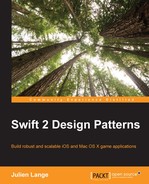Our second pattern is a very well-known pattern. It introduces you to the famous concept: "Program to an interface, not an implementation." The instantiation is done in the factory class that depends on the type that we need and the type that needs to be returned to the client.
The factory method pattern is one of the most used patterns in software designs. The purpose of this pattern is to abstract the creation of an object. The factory method lets a class defer instantiation to subclasses.
You'll see from that time to time that we have mentioned "program to an interface." This is exactly what this pattern does. With Swift, instead of an interface, you'll code with the "protocol" instead of the class itself.
This pattern is used in the following use cases:
- A class only knows about abstract classes or interfaces of objects with whom it has some relationships
- A class wants its subclasses to instantiate the object in order to benefit of polymorphism mechanism
Participant to this pattern are as follows:
- Product interface: This class contains the definition of our product. We will define what a card is here.
- Abstract product: This abstract class implements the signature of our cards and some methods. You'll see that we keep the prototype pattern that allows us to eventually clone a card. These classes define the properties of our products.
- Concrete product: This class defines our product; in our example, the
Raid Leadercard is a concrete product, such as theFaceless Manipulatorcard. - Concrete creator: This class implements our factory method.
In our previous pattern, you would have seen the following line:
let raidLeader = Card(name: "Raid Leader", mana: 3, attack: 2, defense: 2)
Here, we directly program an implementation. We need a way to create some cards, but without having the knowledge to know exactly how to construct the card; we can only tell to create the raidLeader and Faceless Manipulator cards. At this point of time, the client doesn't want to know that the Raid Leader card needs three manas, so it provides two points of attack and two points of defense.
The implementation of the factory method pattern is as follows:
import UIKit
import Foundation
//Define what a card is
protocol Card {
var name: String? {get set}
var attack: Int? {get set}
var defense: Int? {get set}
var mana: Int? {get set}
func clone() -> Card
func toString() -> String
}
// AbstractCard
// implements the signature and some properties
class AbstractCard: NSObject, Card {
private var _name: String?
private var _mana: Int?
private var _attack: Int?
private var _defense: Int?
init(name: String?, mana: Int?, attack: Int?, defense: Int?) {
self._name = name
self._attack = attack
self._defense = defense
self._mana = mana
super.init()
}
override init(){
super.init()
}
//property name
var name: String?{
get{ return _name }
set{ _name = newValue }
}
//property mana
var mana: Int? {
get{ return _mana }
set{ _mana = newValue }
}
//property attack
var attack: Int? {
get{ return _attack }
set{ _attack = newValue }
}
//property attack
var defense: Int? {
get{ return _defense }
set{ _defense = newValue }
}
func clone() -> Card {
return AbstractCard(name: self.name, mana: self.mana, attack: self.attack, defense: self.defense)
}
func toString() -> String{
return ("(self.name, self.mana, self.attack,self.defense)")
}
}
enum CardType {
case FacelessManipulator, RaidLeader
}
// our Factory Class
// Depending what we need, this class return an instance of the
// appropriate object.
class CardFactory{
class func createCard(cardtype: CardType) -> Card?{
switch cardtype {
case .FacelessManipulator:
return FacelessManipulatorCard()
case .RaidLeader:
return RaidLeaderCard()
default:
return nil
}
}
}
//Concrete Card "Raid Leader"
//This is the full definition of the Raid Leader Card
class RaidLeaderCard: AbstractCard {
override init()
{
super.init()
self._mana = 3
self._attack = 2
self._defense = 2
self._name = "Raid Leader"
}
}
//Concrete Card "Faceless Manipulator"
//this is the full definition of the FacelessManipulator Card.
class FacelessManipulatorCard: AbstractCard {
override init()
{
super.init()
self._mana = 5
self._attack = 3
self._defense = 3
self._name = "Faceless Manipulator"
}
}To simulate the use of the factory method pattern by a client, we can write the card creation as follows:
//simulate our client var c = CardFactory.createCard(.FacelessManipulator) c?.toString()
Note
To simulate our client, we simply tell the CardFactory method that we want a FacelessManipulator card.
To do this, we use the createCard method (our factory method), and this method will delegate the instantiation of the card that was asked.
The variable c has the type Card and not FacelessManipulator.

